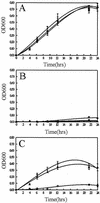BhuR, a virulence-associated outer membrane protein of Bordetella avium, is required for the acquisition of iron from heme and hemoproteins
- PMID: 12228263
- PMCID: PMC128346
- DOI: 10.1128/IAI.70.10.5390-5403.2002
BhuR, a virulence-associated outer membrane protein of Bordetella avium, is required for the acquisition of iron from heme and hemoproteins
Abstract
Iron (Fe) is an essential element for most organisms which must be obtained from the local environment. In the case of pathogenic bacteria, this fundamental element must be acquired from the fluids and tissues of the infected host. A variety of systems have evolved in bacteria for efficient acquisition of host-bound Fe. The gram-negative bacterium Bordetella avium, upon colonization of the avian upper respiratory tract, produces a disease in birds that has striking similarity to whooping cough, a disease caused by the obligate human pathogen Bordetella pertussis. We describe a B. avium Fe utilization locus comprised of bhuR and six accessory genes (rhuIR and bhuSTUV). Genetic manipulations of B. avium confirmed that bhuR, which encodes a putative outer membrane heme receptor, mediates efficient acquisition of Fe from hemin and hemoproteins (hemoglobin, myoglobin, and catalase). BhuR contains motifs which are common to bacterial heme receptors, including a consensus FRAP domain, an NPNL domain, and two TonB boxes. An N-terminal 32-amino-acid segment, putatively required for rhuIR-dependent regulated expression of bhuR, is present in BhuR but not in other bacterial heme receptors. Two forms of BhuR were observed in the outer membrane of B. avium: a 91-kDa polypeptide consistent in size with the predicted mature protein and a smaller 82-kDa polypeptide which lacks the 104 amino acids found at the N terminus of the 91-kDa form. A mutation in hemA was engineered in B. avium to demonstrate that the bacterium transports heme into the cytoplasm in a BhuR-dependent manner. The role of BhuR in virulence was established in turkey poults by use of a competitive-infection model.
Figures







Similar articles
-
RhuR, an extracytoplasmic function sigma factor activator, is essential for heme-dependent expression of the outer membrane heme and hemoprotein receptor of Bordetella avium.Infect Immun. 2004 Feb;72(2):896-907. doi: 10.1128/IAI.72.2.896-907.2004. Infect Immun. 2004. PMID: 14742534 Free PMC article.
-
The Bordetella bhu locus is required for heme iron utilization.J Bacteriol. 2001 Jul;183(14):4278-87. doi: 10.1128/JB.183.14.4278-4287.2001. J Bacteriol. 2001. PMID: 11418569 Free PMC article.
-
Heme utilization in Bordetella avium is regulated by RhuI, a heme-responsive extracytoplasmic function sigma factor.Infect Immun. 2001 Nov;69(11):6951-61. doi: 10.1128/IAI.69.11.6951-6961.2001. Infect Immun. 2001. PMID: 11598070 Free PMC article.
-
Temporal signaling and differential expression of Bordetella iron transport systems: the role of ferrimones and positive regulators.Biometals. 2009 Feb;22(1):33-41. doi: 10.1007/s10534-008-9189-9. Epub 2009 Jan 7. Biometals. 2009. PMID: 19130264 Free PMC article. Review.
-
[Mechanisms and regulation of iron and heme utilization in Gram-negative bacteria].Postepy Biochem. 2005;51(2):198-208. Postepy Biochem. 2005. PMID: 16209357 Review. Polish.
Cited by
-
Involvement of Iron-Containing Proteins in Genome Integrity in Arabidopsis Thaliana.Genome Integr. 2015 Apr 28;6:2. doi: 10.4103/2041-9414.155953. eCollection 2015. Genome Integr. 2015. PMID: 27330736 Free PMC article. Review.
-
Passively released heme from hemoglobin and myoglobin is a potential source of nutrient iron for Bordetella bronchiseptica.Infect Immun. 2007 Oct;75(10):4857-66. doi: 10.1128/IAI.00407-07. Epub 2007 Jul 30. Infect Immun. 2007. PMID: 17664260 Free PMC article.
-
Reduced and Nonreduced Genomes in Paraburkholderia Symbionts of Social Amoebas.mSystems. 2022 Oct 26;7(5):e0056222. doi: 10.1128/msystems.00562-22. Epub 2022 Sep 13. mSystems. 2022. PMID: 36098425 Free PMC article.
-
RhuR, an extracytoplasmic function sigma factor activator, is essential for heme-dependent expression of the outer membrane heme and hemoprotein receptor of Bordetella avium.Infect Immun. 2004 Feb;72(2):896-907. doi: 10.1128/IAI.72.2.896-907.2004. Infect Immun. 2004. PMID: 14742534 Free PMC article.
-
Comprehensive antigen screening identifies Moraxella catarrhalis proteins that induce protection in a mouse pulmonary clearance model.PLoS One. 2013 May 9;8(5):e64422. doi: 10.1371/journal.pone.0064422. Print 2013. PLoS One. 2013. PMID: 23671716 Free PMC article.
References
-
- Biswas, G. D., J. E. Anderson, and P. F. Sparling. 1997. Cloning and functional characterization of Neisseria gonorrhoeae tonB, exbB and exbD genes. Mol. Microbiol. 24:169-179. - PubMed
-
- Braun, V. 1995. Energy-coupled transport and signal transduction through the gram-negative outer membrane via TonB-ExbB-ExbD-dependent receptor proteins. FEMS Microbiol. Rev. 16:295-307. - PubMed
-
- Bullen, J. J., H. J. Rogers, and E. Griffiths. 1978. Role of iron in bacterial infection. Curr. Top. Microbiol. Immunol. 80:1-35. - PubMed
Publication types
MeSH terms
Substances
Associated data
- Actions
Grants and funding
LinkOut - more resources
Full Text Sources
Other Literature Sources
Medical
Miscellaneous

